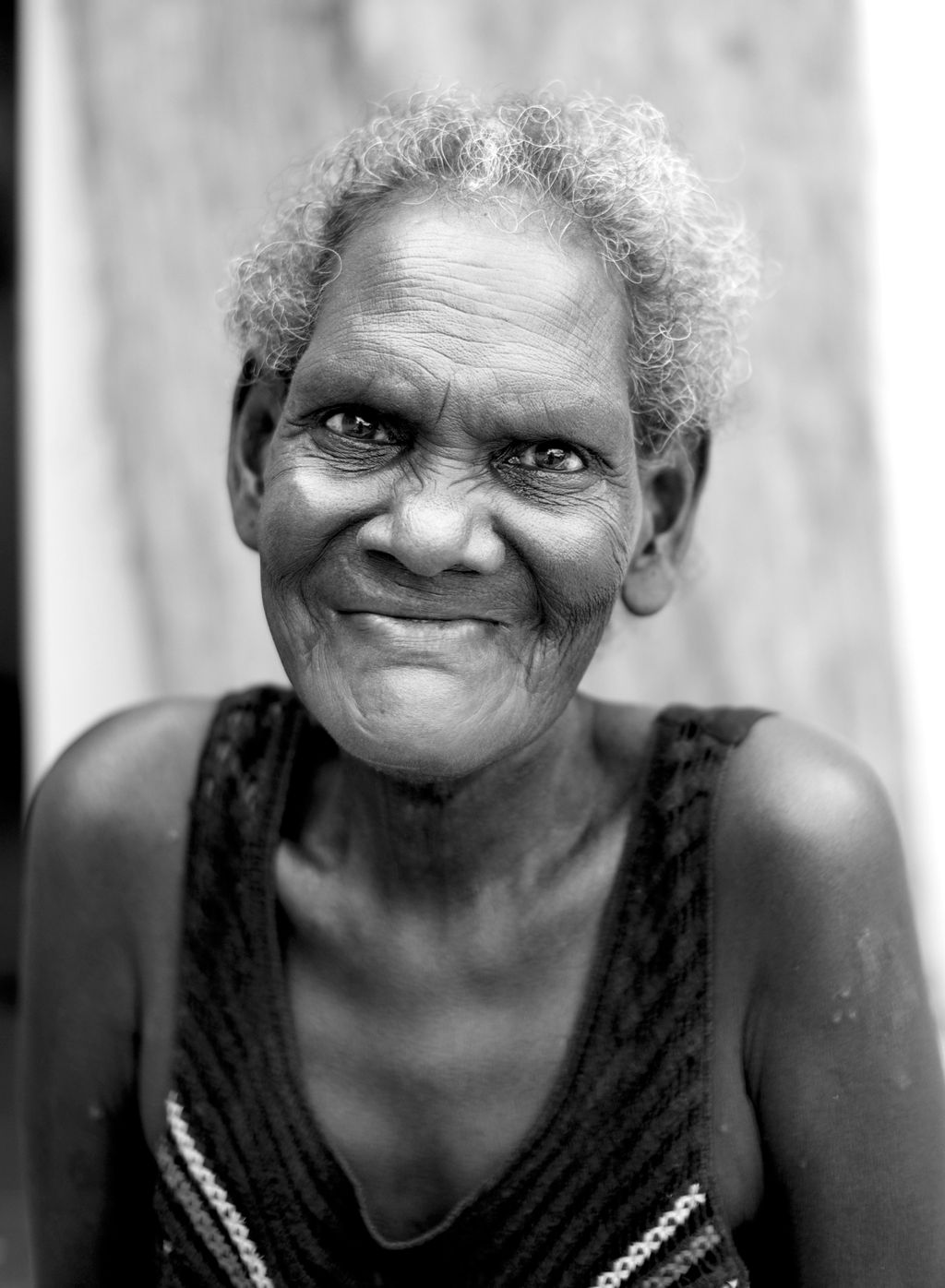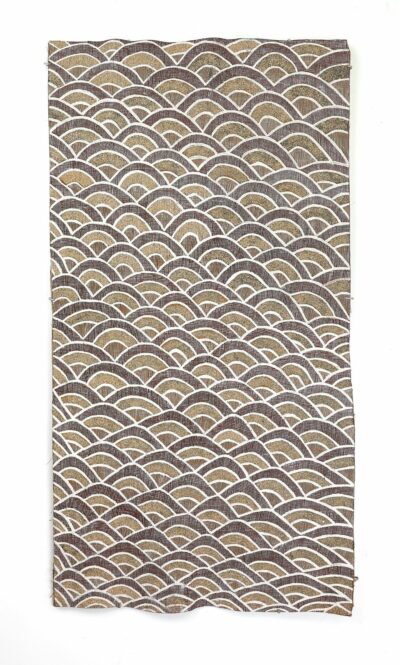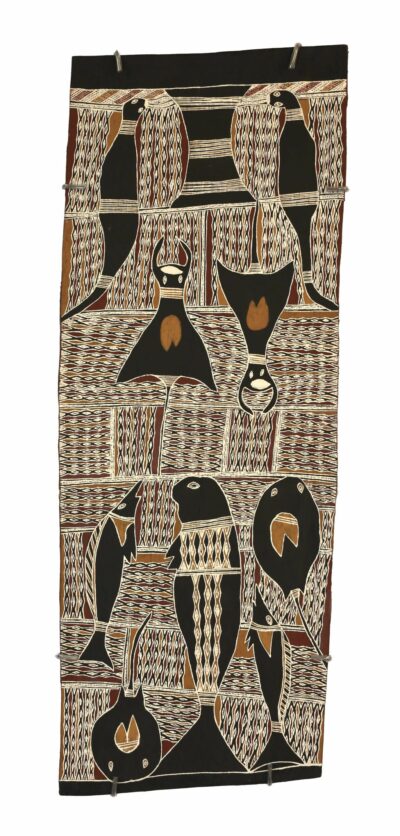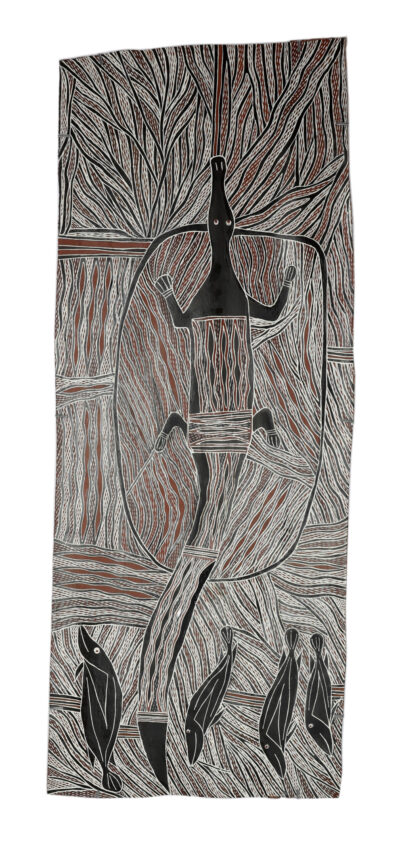Description
ralwurrandji wanambi-dec
Earth pigments on Stringybark
53 x 98cm
Year: 2012
ID: 4158O
Bamurruŋu
This work is a radical departure in style. It marks the time when her sister was gravely ill and there was a ferment of homeland artists in attendance at Yirrkala over a period of months in early to mid 2011. Amongst these was Gunybi Ganambarr and it is possible that the decision to incise and change to a darker palette was influenced by these factors. Included in the work is sand from her sister’s grave. It is rare if not unique to see a plain colour field bleed out to the top and bottom edge in a bark from North east Arnhem. Trial Bay is located between Caledon Bay to the north and above the larger Blue Mud Bay on the western side of the Gulf of Carpentaria. Deep inside Trial Bay the Marrakulu clan claim ownership to land and sea though the actions and events of Ancestor Beings as they travelled into this country imbuing both land and sea. The mark of ownership is sung, danced and painted in Marrakulu ritual through the stringybark woodlands and stony country, through the freshwaters running into the Gurka’wuy River into Trial Bay. Mixing with the saltwaters through sacred mangroves and froth and bubble and out deeper into the Bay with the outgoing tide, past boulders and rocky islets the power and knowledge associated with Marrakulu Rom (law) washes back to shore. This country is associated with the Wawalak Sisters, sacred goannas, Wuyal the Sugerbag Man and the original inhabitants of Gurka’wuy since these times, the Djuwany people. The Djuwany were the first people of this country who practised the ritual according to the Creators on the beaches, who hunted the stony country and waters of both the River and Trial Bay. This painting refers to all this and a sacred and solitary rocks in Trial Bay. These rocks are hidden central to the painting, as they are in the Bay – as round lumps of granite its top coloured by roosting birds, in the painting by the molmulpa or white sea foam associated with turbulent and agitating waters created by particular tide and wind. The cross hatched ribbons containing white depict this molmul also, lines of foam created on the waters surface by the same conditions. These lines connect Bamurruŋu to the mainland of Gurka’wuy by a manifestation of the sacred white feathered string. The red in the ribbons of an organic slick often referred to as coral spawn. The ‘V’ed crosshatched ribbon represents the waters of the Bay that have first washed over, depending on the tide, the roots and the stems of the sacred mangroves on the Gurka’wuy shore – Rulirrika and Gathul Makarr. Fish are sung swimming up to Bamurruŋu are referred to as Marparrarr or milk fish, somewhat like a large mullet. According to the artist these were once people of the stone country behind where the Marrakulu have now settled close the mouth of the Gurka’wuy river. They turned to Marparrarr on reaching the shore and following the feathered string to Bamurruŋu, depicted here encompassing the rock. The Beings of Marparrarr were the ‘same’ as the original inhabitants of Gurka’wuy, in this manifestation, populating Marrakulu sea country as land totems do in this area. Yolŋu of this area speak of a hole submerged under the rock, from where bubbles are seen rising to the surface, sometimes bursting forth with a rush. The bubbles are seen as a life force and a direct Ancestral connection for the Marrakulu. The Marparrarr have knowledge of this special phenomenon as do the law men. The artist explained that here was a ‘statue’ for Mali Djuluwa Makaratjpi. When the Marrakulu perform ritual dance for the events depicted in this painting participants move towards a held spear representing the steadfastness of the rock, splitting the dancers who then surround Bamurruŋa moving as does the sea to song and rhythm of Yidaki and Bilma. This is mirrored by the actions of the fish themselves when they meet a net or other obstacle (such as this rock) when they leap into the dimension of air to free themselves from the mortal coil. This work was chosen by Ruby Alderton to hang in her exhibition Three at the Chan Contemporary Art Space in July 2012.






Reviews
There are no reviews yet.